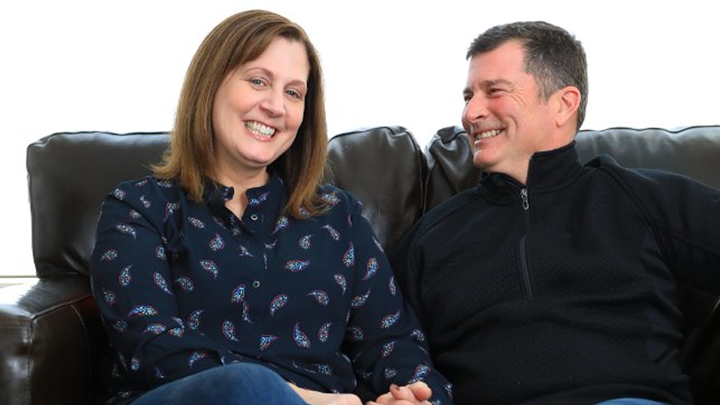
April 25, 2019
Story by Debby Waldman, Photo by Ewan Nicholson
SPRUCE GROVE — Lori Cote is a communications specialist, but when she had to write to her family and tell them that she needed a living kidney donor, she was at a loss for words.
“It was tough,” she admits. “I’m a very proud person. To go to your family and say — ‘I need your help, it’s life and death’ — without making it sound like it’s life and death, was very difficult. It took at least two hours to write that email.”
In her early 30s, Lori experienced pounding headaches that would often last for days. She was soon diagnosed with kidney disease. After her son, Henri, was born, her kidney function never returned to previous levels. By the time Henri entered Grade 1, Lori’s kidney function had diminished to the point where she needed to be hooked up to a machine for 10 hours a night to perform peritoneal dialysis at home.
With an active child now in elementary school, Lori found herself exhausted and unable to keep up. “Being a mom on dialysis with an active six-year-old was tough,” she recalls, her eyes welling with tears.
“I couldn’t run in the park or take him to the splash park because I couldn’t be out in the heat or the sun for long periods of time. Everything Henri wanted to do, I couldn’t. To tell your son no, because Mommy’s sick, is heartbreaking.”
Her doctors at the University of Alberta Hospital advised her to search for a living kidney donor immediately. She reached out to her family right away. Her uncle, a cousin and her brother offered to help. Over the next 18 months, all three underwent extensive testing but, for various reasons, none were a match.
Lori’s care team had also provided her with information about the Kidney Paired Donation program administered by Canadian Blood Services (CBS). Through the program, someone who needs a kidney is matched to another, anonymous person, who’s willing and able to donate a kidney.
“One of the benefits of having a kidney from a living donor is that the living donation can often happen much sooner than a transplant from a deceased donor,” says Dr. Soroush Shojai, a transplant nephrologist at the University of Alberta Hospital, and co-chair of the Living Donor Kidney Transplant Working Group.
“Joining the kidney paired donation program through our transplant programs is an excellent way to increase one’s chances of receiving a living donor kidney transplant, while also benefitting others who are in a similar situation.”
That’s a big reason that Lori’s husband, Rob Cote, stepped in. “I was getting impatient,” he says. “I wanted to find a solution and I knew I wasn’t a match for Lori. So I thought, ‘If I’m healthy and I can donate, then I can go into the Kidney Paired Donation program with Lori, and we can get her a kidney.’”
Rob knew that if he was approved as a donor, then CBS would find a recipient for his kidney and a compatible donor for Lori.
In September 2017, Rob began the extensive donor-testing process. A ski instructor who prides himself on being fit, he said it was an excellent opportunity to learn about the state of his own health. In fact, it was such a positive experience he started encouraging his friends to consider becoming donors, too.
“A kidney from a living donor is usually healthier than one from a deceased donor,” says Dr. Shojai. “The donor undergoes extensive testing to make sure they’re healthy and their kidneys are working very well.”
Rob was approved. Lori received her new kidney in Edmonton in August 2018.
Rob witnessed immediate results. “Her skin tone vastly improved just coming out of surgery,” he recalls. “It’s absolutely amazing to see the difference. I think that’s one of the great things with live kidney donation — that kidney just went to work right away.”
Rob traveled to Calgary for his donation surgery one week later. He doesn’t know who received his kidney. Similarly, Lori’s donor has remained anonymous. All the two know is that five other people were able to receive/donate through their kidney paired donation chain.
"Rob is my hero," Lori says. "We’re a fairly active family, so we’re on the go quite a bit. To have this energy level and be able to keep up with Rob and Henri means the world to me.”
Rob says he feels the same way.
“Now that Lori has a functioning kidney, we can get back to being very active like camping and skiing,” he says. “It’s less complicated: we don't have to make sure that we have all the supplies we need for the dialysis. It was great that we could do those things, but it required quite a bit of planning. Now we just get up and go.”
Lori and Rob agreed to share their story to highlight the importance of National Organ and Tissue Donation Awareness Week (NOTDAW). NOTDAW, which celebrates organ and tissue donation and raises awareness about the critical need for more donors, runs April 21 to 27 this year.

“Rob is my hero,” Lori Cote says of her husband. By joining the Kidney Paired Donation program, their participation completed a living donation chain that benefitted five other people living with kidney disease.
Living Donor Services Transplant Services
University of Alberta Hospital in Edmonton
Phone: 780-407-8698
Toll Free: 1-866-253-6833 (Canada only)
Email: LivingDonors@albertahealthservices.ca
Southern Alberta Transplant Program
Living Donor Program in Calgary
Phone: 403-944-4635
Email: ALTRAFMC.Living.Donor@albertahealthservices.ca
For more information on living kidney donation or kidney transplantation, please visit: myhealth.alberta.ca/HealthTopics/kidney-transplant